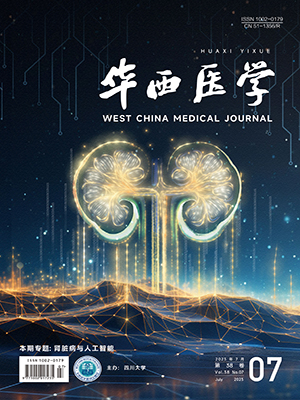【摘要】 目的 探討康復宣教與訓練等干預手段對股骨干骨折患者圍手術期的影響。 方法 2010年6月-2011年3月收治股骨干骨折患者90例,其中男48例,女42例;年齡17~58歲,平均38歲。開放性骨折28例,閉合性骨折62例。股骨骨折部位:上1/3骨折33例,中1/3骨折35例,下1/3骨折20例,多段骨折2例。橫形骨折20例,斜形骨折30例,粉碎性骨折40例。將90例患者隨機分為康復組(46例)和對照組(44例)。對照組采用骨科術前常規處理,康復組采用骨科術前常規處理加康復宣教與訓練。 結果 康復組住院時間為(5.35±1.27) d,對照組為(7.67±1.85) d,兩組比較差異有統計學意義(P lt;0.05)。 康復組治療后發生并發癥7例,對照組16例,康復組并發癥發生率(15.2%)明顯低于對照組(36.4%),差異有統計學意義(P lt;0.05)。治療后5 d,康復組療效獲優35例,良6例,可3例,差2例,優良率89.1%;對照組獲優25例,良5例,可12例,差2例,優良率68.2%;兩組療效比較差異有統計學意義(P lt;0.05)。 結論 康復宣教與訓練能預防與改善股骨干骨折圍手術期臥床引起的并發癥,減輕患者腿部疼痛及腫脹,縮短圍手術期時間,使患者能盡早手術,加快住院床位周轉,提高患者生活質量。
【Abstract】 Objective To explore the effects of rehabilitation education and training interventions on perioperative patients with femoral shaft fractures. Methods A total of 90 patients with femoral shaft fractures were selected from June 2010 to March 2011, including 48 males and 42 females aged from 17 to 58 years (mean 38 years). In these 90 patients, open fracture was in 28 and closed fracture was in 62. Fracture site: upper 1/3 fracture was in 33, middle 1/3 fracture was in 35, lower 1/3 fracture was in 20 and multiple fractures was in 2. There were transverse fractures in 20 patients, oblique fractures in 30 patients and comminuted fractures in 40 patients. All of the patients were randomly divided into experimental group (46 patients) and control group (44 patients). The patients in the control group underwent the routine treatment before the orthopedic surgery; besides the routine treatment, the patients in the experimental group were given the rehabilitation education and training before the orthopedic surgery. Results The hospital duration in the rehabilitation group was (5.35±1.27) days while in the control group was (7.67±1.85) days, the difference was statistically significant (P lt;0.05). There were 7 cases who had complications in rehabilitation group compared with 16 patients in the control group; the incidence of the complications in the rehabilitation group (15.2%) was significantly lower than that in the control group (36.4%) (P lt;0.05). After the treatment for 5 days, the therapeutic effect in rehabilitation group were excellent in 35 cases, good in 6 cases, middle in 3 cases and poor in 2 cases (with the good rate of 89.1%); while in the control group were excellent in 25 cases, good in 5 cases, middle in 12 cases and poor in 2 cases (with the good rate of 68.2%); the difference was significant between the two groups (P lt;0.05). Conclusion Rehabilitation education and training could prevent the perioperative complications in patients with femoral shaft fracture, decrease the pain and edema, speed up the turnover of hospital beds, and improve the patients’ quality of life.
引用本文: 張少軍,趙正恩,黎孝富,周皓,高強,劉楊,李簞. 圍手術期康復宣教與訓練對股骨干骨折患者的影響. 華西醫學, 2011, 26(8): 1159-1161. doi: 復制




